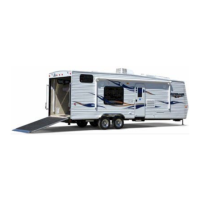FIRE EXTINGUISHER
A portable fire extinguisher can save lives and
property by putting out a small fire or
containing it until the fire department arrives;
but portable extinguishers have limitations. It is
important to recognize when to leave the RV.
Because fire grows and spreads so rapidly, the
number one priority is to get out safely. The
Underwriter Laboratories (UL) classify
household fire extinguishers into four types:
Rating Intended Use
Type A
For use on fires involving combustible
materials such as wood, cloth and paper.
Type B
For use on flammable liquid fires,
including kitchen grease. Never use water
on this type of fire!
Type C
For use in fires involving energized
electrical equipment
Type
ABC
Works on all three types of fires listed
above.
The factory-installed dry chemical fire
extinguisher, suitable for extinguishing small
fires of the Class B and Class C type, is
located near the entry door.
Operation
Keep your back to a clear exit when you use
the fire extinguisher so you can make an easy
escape if the fire cannot be controlled. If the
room fills with smoke, leave immediately.
Know when to leave. Fire extinguishers are
one element of a fire response plan, but the
primary element is safe escape.
There are different types and sizes of fire
extinguishers, but for the most part they all
work the same way. To operate a fire
extinguisher, remember the word PASS.
Pull the pin. Hold the extinguisher with the
nozzle pointing away from you, and release
the locking mechanism.
Aim low. Point the extinguisher at the base of
the fire.
Squeeze the lever slowly and evenly.
Sweep the nozzle from side-to-side until the
fire is out.
Disposal
Contact your local fire department, sanitation
department or environmental protection
department to find out what your local laws
stipulate before disposing of your used
(non-refillable) factory-installed dry chemical
fire extinguisher.
SMOKE ALARM
Three of the most common fire safety issues
are smoking in bed, leaving children
unattended and cleaning with flammable
fluids. There is no way to guarantee against
injury or loss of life in a fire; however, the
smoke alarm is intended to help reduce those
risks. Individuals with medical problems, or
who are hard of hearing, should consider using
warning devices that provide both audible and
visual signals.
Proper use and care of your smoke alarm may
save your life. Smoke alarms can only work if
they are properly located, installed,
operational and maintained and if smoke
13
SECTION 2
OCCUPANT SAFETY
CAUTION
Avoid inhaling the dry chemical agent in the
fire extinguisher. It is not toxic, but may
cause skin irritation. In case of contact,
flush the affected area with clean, cool
water. If irritation persists, contact a
physician immediately.

